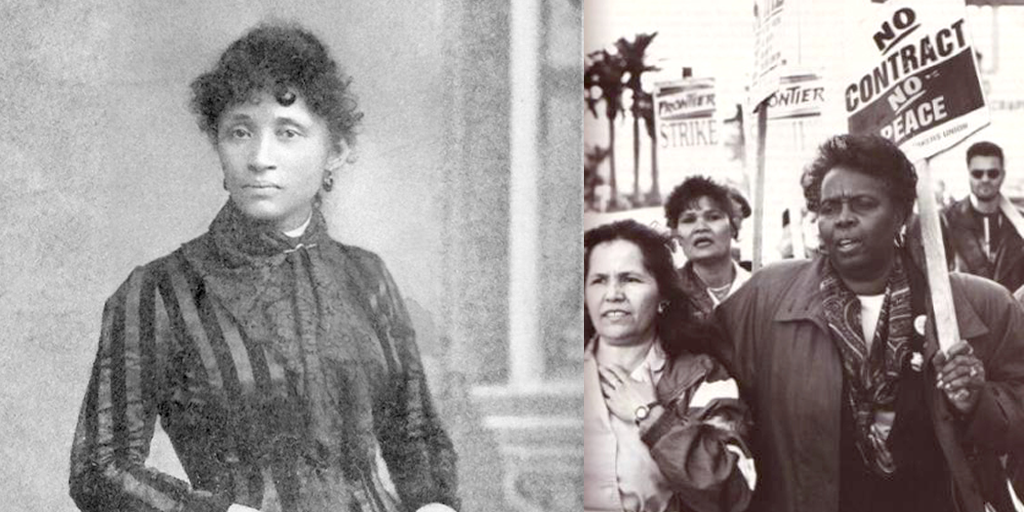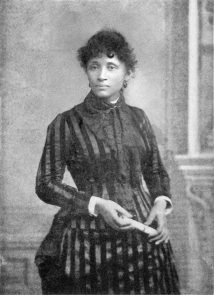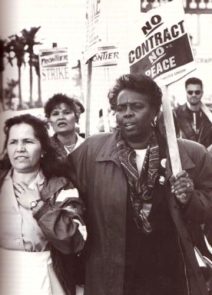Black Women Built That: Labor and Workers’ Rights

In honor of Black History Month, “Black Women Built That” is a series celebrating Black women leaders who have shaped our social, political and cultural life. Without their contributions, our country would be unrecognizable.
Black women have been essential leaders across social justice movements, and the labor movement is no exception. Despite historical segregation that kept women and Black workers out of some of the most powerful labor unions in the United States, Black women have led past and present struggles for economic justice – even as their contributions were often ignored by the history books. This Black History Month, we are making space to highlight a few of the radical Black women who have dedicated their lives to organizing; women who fought long and hard, so that all working people can realize not just basic workplace rights, but a life of dignity, respect, and joy. As the saying (coined by another radical female labor leader) goes, workers deserve bread – the basics like a living wages and safe working conditions, and we deserve roses too.
Although Lucy Parsons and Hattie Canty organized in radically different settings – neither shied away from the people who matter most – the individuals doing difficult and dirty work, the lowest paid and the least respected by others in society. While Parsons agitated on behalf of all working poor in Chicago, Canty focused her efforts on raising up the working conditions of all in her union, Las Vegas Local 226. Both of these women were giants in their time and place.
Lucy Parsons: More Dangerous Than a Thousand Rioters (1853–1942)

First up, is the woman who was known by the Chicago police department as “more dangerous than a thousand rioters,” Lucy Parsons. Parsons was a dedicated anarchist and labor organizer who struggled throughout her life for freedom and against state repression through the establishment of some of the most storied institutions in U.S. labor history. Parsons played a significant role in the fight for the eight-hour workday, the organization of the first May Day, the founding of the International Ladies Garment Workers Union (ILGWU), and the Industrial Workers of the World (the IWW).
The causes to which she dedicated her life are central to the collective struggles of so many Black workers during the near-century in which she was alive and continue to be issues of critical concern for Black workers today: economic freedom, autonomy and dignity among the poor. Parsons understood that in order for women to be free from oppression, organizing requires an intersectional framework that focused on solidarity among the working poor to push back on the ills and excess of capitalism, which in her time, looked like the dangerous and dirty factory floors of a newly-industrialized Chicago.
Decades before it was en vogue, Parsons believed that rather than be guided by individual institutions and causes, it was essential for a poor people’s movement to maintain a steady focus on the most oppressed and most marginalized, and from that focus, would come liberation for everyone. Though records are scarce, Parsons was born around 1853 in the south, likely to parents who were slaves. She spent her early life in Texas. In the 1870’s she married a white anarchist, Albert Parsons, who in 1887 was put to death for his alleged involvement in the famous Chicago Haymarket Riots. The couple spent their lives in Chicago, writing and editing radical newspapers, creating institutions and organizing among poor people.
Although today we take an eight-hour workday for granted, in the United States in the 1880’s, workers routinely labored for ten hours each day or longer. An eight-hour workday was considered a radical departure from the norm. Even so, Parsons initially had no love for the eight-hour a day movement, believing it too reformist of a view. She believed that to support an eight-hour workday was a concession to the hourly wage system itself. She was more interested in complete worker ownership over all that labor produces. However, as the movement for an eight-hour workday became the issue of the day, Parsons and the International Ladies Garment Workers Union decided to back the cause and began organizing sewing women in support of an eight-hour day strike, and to join the Knights of Labor, one of the largest and most prominent unions of the time and a leading organization fighting for the eight hour day. On May 1, 1886, Parsons helped to launch the first May Day. Along with her husband and their two children, they led 80,000 working people down the Chicago streets carrying banners demanding an eight-hour work day with no reduction in pay. Two days later, on May 3, between 300-400 sewing women who were at work and unable to march two days earlier, also took to the streets in support of the eight-hour workday, and collectively joined the Knights of Labor. That first May Day ignited an unstoppable movement towards an eight-hour work day, which has become standard practice in most American workplaces. Parsons continued to advocate for workers’ rights throughout her life, including being only one of two women invited to be present at the founding of the IWW, and the only woman to speak.
Parsons’ core political beliefs were far from mainstream. She was considered an extremist for advocating for nothing less than the complete abolition of waged work and not always by non-violent means. While we may disagree with Parsons on some of her tactics, we look to her example as a lesson in how to dream beyond the popular reforms of the day, in how to reach beyond the piecemeal wins, and keep our eyes on the prize: full equality and dignity for all in our society.
Hattie Canty: One of the Greatest Strike Leaders in U.S. History (1933–2012)

Born in rural Alabama in 1933, Hattie Canty was one of the greatest strike leaders in U.S. history. She found work as a cook in California before settling in Las Vegas with her husband, who supported the family and ten children. Except for a short stint working as a maid at the Thunderbird Hotel in Las Vegas in 1972, Canty largely stayed home to raise the family’s ten children. In 1975, her husband fell ill and succumbed to lung cancer. Facing the prospect of caring for eight of her children who were still living at home, 41-year-old Canty took another maid job at a hotel – this time the Maxim – a hotel unionized with Las Vegas Culinary Workers Union Local 226. Because of the union, the job afforded Canty health benefits, a pension, and wages far above the minimum wage. Over the next dozen years, Canty rose through the ranks, being promoted from maid to attendant. She spent every one of her off-days walking a picket line when there was a picket line to walk.
In May 1990, the membership of the union elected Canty president – the first woman president of the local – and a position she held for ten years.
Under her leadership, the Local engaged in what became one of the longest strikes in US History, which lasted 6 years, 4 months and ten days between 1991 and 1998. In 1991, 550 hospitality workers at the Vegas Frontier Hotel walked off their jobs to protest unfair wages and treatment. Over the next six years, the union maintained a strike line 24 hours a day, seven days a week and no striker ever crossed the picket line. The strike ended in victory when the Frontier was bought by another businessman, who promised to restore the workers to their jobs, honor the union contract, and provide back pay for the workers.
During an oral history in 2007, Canty had this to say about striking: “… when there’s a strike like that, you’re not just striking for the benefits from that hotel. But you are learning to take up for yourself. You are learning to defend your rights. You are not letting people just run over you or you’re taking anything they give you.”
Hattie Canty was a dynamic leader who also worked to better integrate the union and address racial tensions. She was not only a fearless advocate, going to jail at least six times to defend the union, but a strategic institution builder. For example, she established a culinary training academy that helped train workers to gain promotions in the industry. Canty rose through the ranks, as a largely uneducated hotel worker, to become a union president and strike leader, strengthening the foundation of what remains one of the strongest union locals in the country today.
These are just two of thousands of Black women throughout our nation’s history who have fought for the rights of working people as community leaders for the benefit of all of us. We owe Lucy Parsons, Hattie Canty, and so many more a debt of gratitude for the rights we often take for granted today.
Learn about more of today’s Black women labor leaders by checking out the groundbreaking history project: And Still I Rise.




